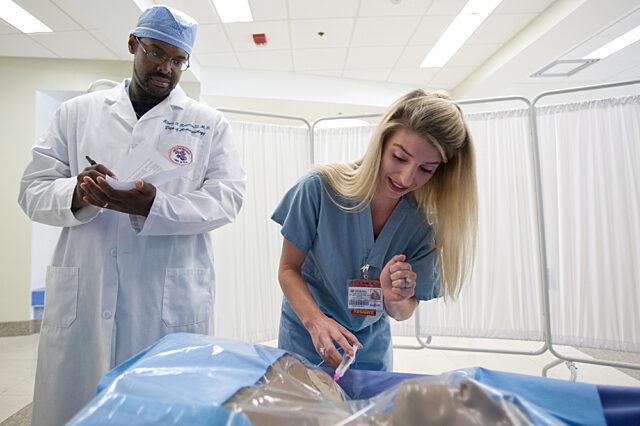Residents test new simulator for safety

Albert R. Robinson, M.D., an assistant professor of anesthesiology at the College of Medicine, shows Zachary Kramer, M.D., a first-year emergency medicine resident, his results of the central venous catheter placement simulation. The department of anesthesiology in the College of Medicine is surveying whether the central venous catheter placement simulation is effective in teaching residents. (Photos by Maria Farias/University of Florida)
University of Florida emergency medicine residents tested a new UF-developed mixed reality simulator in September that lets the user get valuable experience in a safe way.
Residents practiced on a subclavian central venous access simulator by injecting the tip of a needle directly into the subclavian vein of a digital dummy while avoiding its artery and lung.
The dummy, which is only a head and torso, is pierced with a needle that is tipped with a sensor the size of a grain of rice. The sensor tracks and records 3-D images of where the needle moves in the body and tells the user whether he or she has hit a vital organ or the desired vein.
The exercise was also a study to determine whether the simulator is an effective learning tool to improve skill and safety habits. The study is spearheaded by Al Robinson, M.D.
Zachary Kramer, M.D., an emergency medicine resident, tried his hand at the tool. He’s done this procedure before so he didn’t have any trouble the two times he tried.
“I definitely think it’s a great learning tool … especially for someone who’s never done it before,” Kramer said.
Sem Lampotang, Ph.D., director of the Center for Safety, Simulation & Advanced Learning Technologies, said UF has applied for a patent for the technology. Nikolaus Gravenstein, M.D., David Lizdas and Isaac Luria, M.S., also helped develop the simulator.
“The preliminary results show that it seems to be making a difference,” Lampotang said. “The residents’ performance is getting better.”
 Albert R. Robinson, M.D., an assistant professor of anesthesiology at the College of Medicine, watches Elizabeth Flail, M.D., a first-year emergency medicine resident, place a central venous catheter during a placement simulation. The department of anesthesiology in the College of Medicine is surveying whether the central venous catheter placement simulation is effective in teaching residents. (Photos by Maria Farias/University of Florida)
Albert R. Robinson, M.D., an assistant professor of anesthesiology at the College of Medicine, watches Elizabeth Flail, M.D., a first-year emergency medicine resident, place a central venous catheter during a placement simulation. The department of anesthesiology in the College of Medicine is surveying whether the central venous catheter placement simulation is effective in teaching residents. (Photos by Maria Farias/University of Florida)